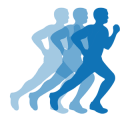The following exercises form part of our full Osgood Schlatter disease rehabilitation and recovery program. They include stretching, strengthening, foam roller and functional exercises which are done in conjunction with rest and treatment methods.
Stretching exercises
Stretching exercises, particularly for the quadriceps muscles can be done as soon as pain allows.
Quadriceps stretch
Standing quad stretch and hold for up to 45 seconds.
Foam roller
Use a foam roller over your quadriceps (front thigh) before stretching. Use along the full length of the muscle with more emphasis or weight from the knee upwards, following the direction of blood flow along the muscles.
Strengthening exercises
Because Osgood Schlatter disease is primarily an overuse injury, the emphasis is always on rest and recovery. However, the long-term aim is to gradually increase the load on your knee in a controlled manner. See our full rehab program for specific details on which exercises to do, and when.
VMO activation

Keeping the uninvolved knee in place, tighten the involved knee by pushing it into the table. To position the knee in partial flexion place a towel or roll under the knee. The knee is straightened (keeping the other knee flexed) and held in full extension.
Turning your foot outwards helps isolate this muscle more. Contract your quadriceps muscles, making sure the VMO on the inside of the knee is contracting.
Isometric knee extension
This can be done on a leg extension machine at the gym, or using an elastic resistance band. If you prefer you can also substitute this exercise for an isometric leg press
Single leg press
Increase the sets and reps as your knee improves.
Single-leg knee extension
Single leg bridge
Lie on your back, knee bent, and push the hips upwards. Use one foot on the floor pushing up. Hold the position briefly and then lower it. Make sure you squeeze the gluteal muscles and aim to maintain a straight line from the shoulder on the ground to the knee at the top point of the exercise.
Reverse lunge
Bend your back leg so your back knee will nearly touch the ground, and your front knee so your thigh is about parallel to the ground. Your front leg is the one that is working.
Single leg RDL
The standing leg stays fairly straight. Reach out and backwards with the free leg. Challenges stability around your hips.
Single-leg calf raise
Ideally, these should be performed in a gym using a Squat (Smith’s) machine so you can increase the load on the muscles.
Functional exercises
These are more sports-specific type exercises and bridge the gap between basic strengthening and sports-specific training.
High knee step up
The working leg is on the step. The other leg comes up into a hip flexion position (90 deg).
High knee reach out
High knee lifts into a lateral reach out. Toes should be pulled up towards the ceiling. Great for hip mobility, and quad and glute activation.
Drop jump
Simply jump/drop off a step. Absorb the impact with your legs, briefly holding the position at the bottom.
